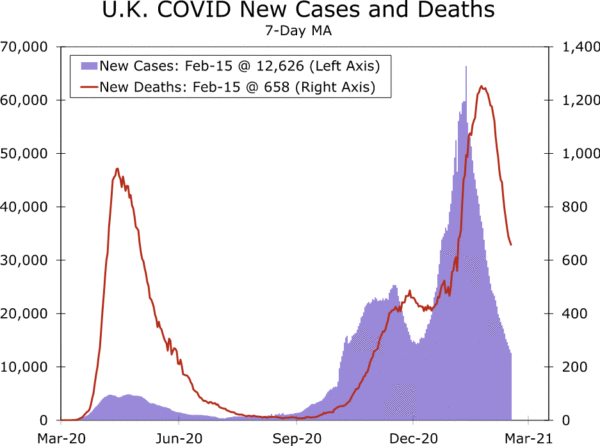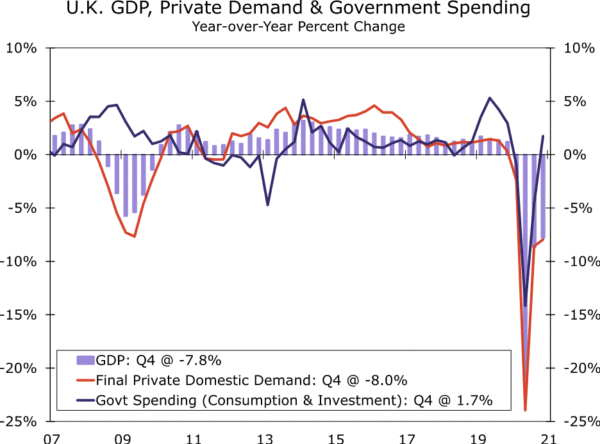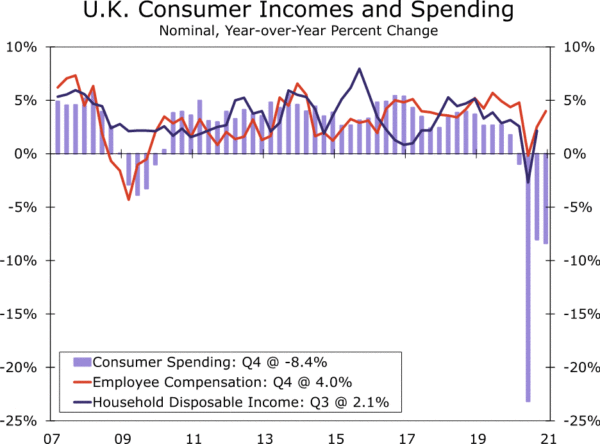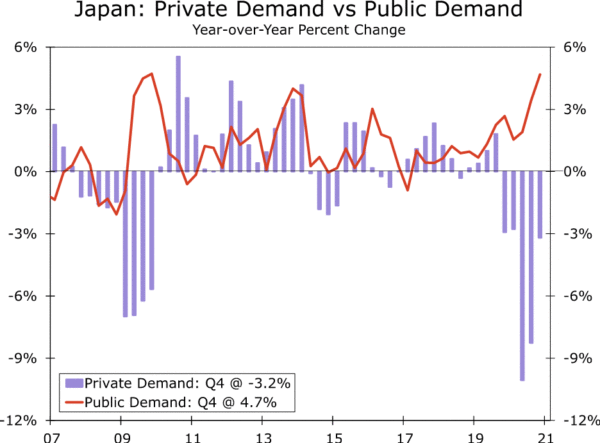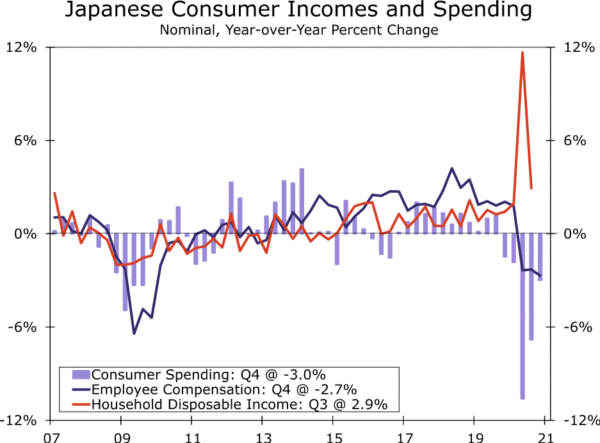Summary
- The U.K. economy outperformed expectations in Q4, growing 1.0% quarter-over-quarter; however, some of the underlying details of the GDP report were less favorable. Government spending was largely responsible for the outperformance, while consumer spending turned negative in Q4, an unwelcome decline. With COVID restrictions reimposed for most of Q1, the near-term outlook for the U.K. economy remains challenging. However, the longer-term prospects are brighter as household finances continue to improve and could result in a pronounced rebound in consumer spending in a post-COVID world.
- Japan’s economy also beat consensus forecasts in Q4 with the underlying details more constructive when compared to the United Kingdom. Despite a relatively strong Q4 our medium-to-longer term view for Japan is less encouraging. Current COVID restrictions are imposed on a significant portion of the economy, while household finances in Japan are not as strong currently as in the U.K. In order for the Japanese economy to gather longer-term momentum, additional fiscal stimulus may be required in an effort to support consumer spending.
- There are slight differences in our outlooks for the British pound and Japanese yen as we expect modest pound strength and gradual yen weakness over our forecast horizon. While the pound has already reached out medium-term target, we believe a renewed downturn in the U.K. economy will restrain the pound for now. In addition, a global economic recovery along with subdued medium-term prospects for the Japanese economy should reduce demand for haven currencies and also weigh on the yen over time.
United Kingdom Sees Government-Led Growth in Q4
The United Kingdom’s Q4 GDP release was a favorable surprise and, while there were certainly some positive elements within the report, not all the details were as constructive as the headline figure. Overall GDP growth surprised to the upside, rising 1.0% quarter-over-quarter, double the consensus forecast for a 0.5% gain. However, much of the growth was led by government spending (both consumption and investment), which we estimate jumped by 6.3% quarter-over-quarter. Business investment also rose by 1.3%, but consumer spending actually dipped during Q4. As a result, our estimate of U.K. final private domestic demand managed barely positive growth at 0.1% quarter-over-quarter. Thus, while overall GDP grew at a respectable pace late last year, growth in the private sector was very tepid.
In addition to concerns about the composition of U.K. economic growth in Q4 there is also concern, or more accurately widespread expectation, of a renewed economic contraction in the first quarter of 2021. In November, the United Kingdom saw a renewed surge in COVID cases and again in early 2021, which led the U.K. government to reimpose restrictions. After a relatively brief lockdown during November, the U.K. government implemented strict national COVID measures from early January 2021. Protocol included restricting individuals from leaving their home unless it is for a permitted reason such as shopping for basic necessities, going to work if you cannot reasonably do so from home, exercising with your household or support bubble in a public outdoor space, meeting your support bubble, seeking medical assistance or attending education or childcare. The government opted to keep colleges, primary and secondary schools open only for vulnerable children and the children of critical workers; however, all other children are expected to learn remotely until March 8, while higher education is set to remain online until March 8 at the earliest. Still after daily new COVID cases peaked at more than 60,000 in mid-January, the effect of these lockdown measures, combined with the vaccine rollout, has seen the spread of COVID slow significantly. As a result, the U.K. government has signaled it will outline on February 22 a tentative timetable for exiting the current lockdown restrictions.
Source: Bloomberg LP and Wells Fargo Securities
Still, even as developments on the virus front improve, the U.K. economy looks certain to suffer a notable hit to activity during the first quarter. Economic figures so far have been sparse, but survey data clearly point to a sharp downturn. The January services PMI fell to 39.4, the lowest level since May 2020, while a Confederation of British Industry retailers’ survey also indicated a significant weakening in reported sales in early 2021. The consensus forecast for Q1 looks for GDP to fall by 3.5% quarter-over-quarter, while in its most recent economic forecast the Bank of England projected an even larger 4.0% decline. Clearly, the immediate outlook for the U.K. economy is uncertain and unsettled.
However, our medium-to-longer term outlook for the economy is more encouraging, especially as household finances remain in reasonably sound shape. After declining in Q2-2020, both employee compensation (+3.8% quarter-over-quarter) and household disposable income (+4.9%) enjoyed sizable rebounds in Q3. For Q4, employee compensation rose a further 2.4%, which we think likely translates into another rise in Q4 disposable income as well. Moreover, we note that employee compensation and disposable incomes are above year-ago levels. Finally, given the apparent rise in Q4 household incomes and the stagnation in consumer spending, it is likely the household saving rate rose further from the already 16.9% of disposable income in Q3. The bottom line is that U.K. households are well positioned to generate a rebound in consumer spending as the economy re-opens.
Japan Enjoys More Broad-Based Growth in Late 2020
In contrast to the United Kingdom, Japan enjoyed stronger and more broad-based growth late last year. Japan’s Q4 GDP rose 3.0% quarter-over-quarter (not annualized), beating the consensus forecast for a 2.4% rise. Most demand components reported increases including consumer spending (+2.2% quarter-over-quarter) and business capital spending (+4.5%). As a result, private demand rose 2.0%, while public demand rose 1.8%, and the net export sector also contributed to the Q4 growth outcome. Given a second relatively solid sequential gain in activity, overall Q4 GDP was down just 1.2% year-over-year.
As with the United Kingdom, however, Japan’s economy faces a more unsettled outlook in early 2021. The early part of this year saw a surge in new COVID cases well above previous peaks even if, on an absolute basis, the spread was less notable than the U.K. The fast pace of increase in new COVID cases was seen in mid-January at around 6,500 new cases per day, although case counts have receded subsequently. As the number of newly reported COVID infections reached record levels, the Japanese government declared a state of emergency in January, which was later extended in February in order to prevent the spread of the virus. The implementation of emergency measures is set to remain in place until March 7 and are imposed in several regions including Saitama, Chiba, Tokyo, Kanagawa, Gifu, Aichi, Kyoto, Osaka, Hyogo and Fukuoka, which account for around 60% of the country’s economy. The declaration of the state of emergency focuses on minimizing situations with a high risk of infection, and urges residents to refrain from leaving the house and traveling around the city. In addition, large events are required to be scaled back and restaurants and karaoke bars are suggested to shorten their business hours to only be open until 8PM. In addition, amusement centers and large-scale stores are also requested to follow the same structure and close at 8PM. Once again it is survey data that primarily point to a likely downturn in Japan’s Q1 GDP, with the January economy watchers’ survey falling to 30.1 and January consumer confidence dropping to 29.6. First quarter GDP is expected to see a contraction, albeit by less than the U.K. economy, with the consensus forecast for a decline of 0.6% quarter-over-quarter (not annualized).
While the immediate hit to Japan’s economy might be less than the U.K., the medium-to-longer term recovery might be more gradual. Japanese employee compensation rose just 0.3% quarter-over-quarter in Q4, much less than the rise in consumer spending, while employee compensation also remains 2.7% below its year-ago level. Considering the relative compensation and spending moves, it is quite possible that Japan’s household saving rate fell again in Q4, after the spike seen in mid-2020. Overall, recent trends in Japanese household finances seem somewhat less favorable than in the United Kingdom, and the prospects for medium-term recovery in Japanese consumer spending and overall GDP may depend importantly on the extent of further fiscal stimulus.
Prospects for the British Pound and Japanese Yen
The U.K. currency has strengthened markedly in recent weeks, as some economic figures have shown resilience, but more particularly as Bank of England policymakers have downplayed the prospects of further monetary easing and, in particular, a move toward negative policy interest rates. As we highlighted, however, at least for the near-term, the composition of U.K. economic growth remains less than ideal in that the contribution from the private sector is relatively modest. As a result, signs of a sluggish domestic economy still have the potential to weigh on the pound at times. Acknowledging GBP/USD has already reached our medium-term target of $1.3800, we still believe periods of weakness in the U.K. currency are possible and that appreciation in the pound will likely be gradual over the medium term.
The somewhat more cautious medium-term outlook for Japan’s economy is broadly consistent with our outlook for gradual weakness in the yen versus the U.S. dollar. That said, the Bank of Japan’s next monetary policy announcement on March 19, at which it plans to announce the results of its policy strategy review, looms as a potentially important market event. We note that 10-year Japanese government bond yields have edged higher in recent weeks. A widening of the central bank tolerance band from the current zero +/- 20 basis points could arguably allow scope for that drift higher to continue, which could be positive for the yen. On the flip side, there has also been some market discussion, indicating the Bank of Japan might highlight the potential for further rate cuts, even if it is not expected to lower rates in March. Both of course are possible, along with other options, which would be more of a mixed message. Considering the moderate medium-term outlook for the economy and potential for a range of outcomes from the central bank’s policy strategy review, we remain comfortable with our view of modest yen weakness over time.




